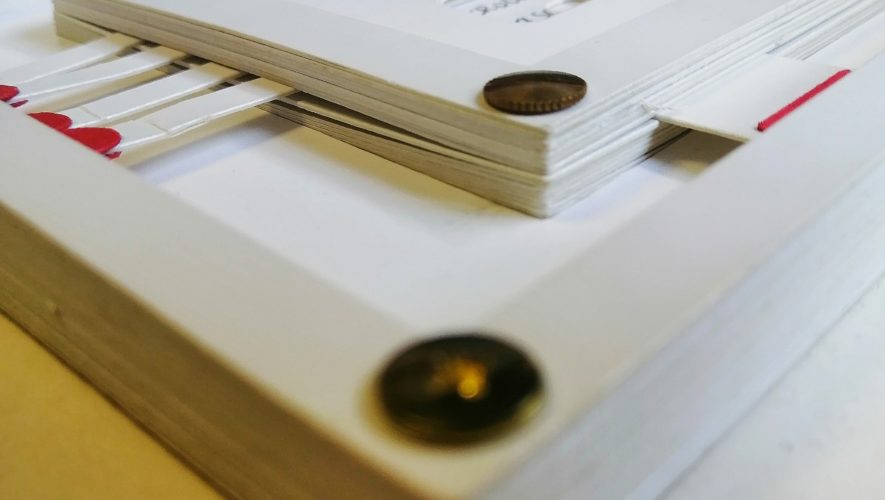Continua il discorso tra Daniela Calisi, autrice di Change e Rachele Cataldo, esperta di data visualization con cui condivide l’amore per l’interactive art.
Questa poesia si chiama “capace di cambiare”, in inglese change, “cambiamento” e dal punto di vista contenutistico parla proprio di questo, della capacità di cambiare, del fatto che ci possono essere dei cambiamenti anche laddove non te lo aspetteresti mai: come in un testo di carta. Questo è un po’ il senso intrinseco dell’opera che hai in mano, addirittura in un pezzo di legno.
A un certo punto della mia vita io mi sono resa conto di esserne in grado. Il testo della poesia vuole riflettere proprio questo.
Passa da un certo modo di affrontare la vita, con tutte le sue mutazioni interne e le sue variazioni. Anche nel testo sono tecnicamente degli “stati” del testo; da uno stato all’altro ci sono due approcci estremi verso la vita, uno passivo e uno attivo. Nel nell’intervallo tra i due ci sono delle tappe-stato intermedie.
Ha poi anche un aspetto di esortazione: questo è un oggetto che si può muovere ma non si muove se non sei tu che lo muovi. È l’oggetto stesso a narrare questo pezzo di storia: non è scritto nelle sue parole, bensì nella sua forma.
Quindi c’è un parallelismo tra il piano contenutistico, il piano formale e il piano interattivo. Tutto è coniugato, e questo è appunto l’altissimo valore poetico di questo oggetto. Questo simbolismo viene tradotto su diversi livelli.
I miei testi e le mie opere hanno una loro prossemica, delle caratteristiche che ti parlano di come devi gestirli. Questi pallini rossi suggeriscono dove toccare, dove tirare. In un certo senso, il testo ha una sua presa di posizione.
Questo è un altro tema di tipo sociale che Change contiene. Anche se il testo ha una sua presa di posizione, questo non significa che non sia disposto a cambiarla. Che è un po’ come io vedo il conflitto. Io sono una persona molto assertiva, sono capace di andare in una discussione veramente alla radice delle questioni e portare avanti il mio ragionamento fino all’estremo e questo fa pensare a molte persone che io sia una persona molto testarda. In realtà lo sono pochissimo. Sono una persona disposta a cambiare idea e che non vede l’ora di cambiare idea. I miei testi affermano in continuazione questa cosa, appaiono complessi, radicali, meccanici e definiti, ma sono molto fluidi. Questa è una mia caratteristica personale che si riflette nei miei testi molto più di quanto io non sia in grado di esprimerla personalmente.
Ognuno si esprime come può.
Classico dell’artista.
Sono riuscita a tirare fuori cose che non ero mai riuscita a tirare fuori. Non sono mai riuscita ad esprimere il rapporto tra i meccanismi, ovvero come mi sento io, se non con questi meccanismi prossemici.
Questo tu progetto mi ricorda la trans-poesia: quella poesia che non volendo limitarsi alla bidimensionalità del testo per riprodurre i diversi passaggi mediatici punta a riprodurne anche la profondità.

Vérsion Française
On continue le discours entre Daniela Calisi, autrice de Change, et Rachele Cataldo, experte de data vizualization avec laquelle elle partage l’amour pour l’interactive art.
LA GALAXIE EVENTAIL VOL. 11 : Change
Cette poésie s’appelle « capable à changer », en anglais change, changement : en termes de contenus, c’est propre ça, la capacité de changer, le fait qu’il y a un changement même où on ne s’y attend jamais : comme dans un texte de papier. C’est ca le sens de l’œuvre que vous avez dans les mains, même dans un pièce de bois.
Dans un certain moment de ma vie, j’ai réalisé que j’en étais capable. C’est ce que le texte de la poésie veut refléter. Elle passe par une certaine façon d’affronter la vie, avec toutes ses mutations internes et ses variations. Même dans le texte ils sont techniquement des “états” du texte ; d’un état à l’autre il y a deux approches extrêmes vers la vie, un passif et un actif. Dans l’intervalle entre les deux il y a des étapes-état intermédiaires. Il a aussi un aspect d’exhortation : c’est un objet qui peut se déplacer mais qui ne se bouge pas si ce n’êtes pas vous à le déplacer. C’est l’objet lui-même qui raconte ce pièce d’histoire : il n’est pas écrit dans ses paroles, mais dans sa forme.
Il y a donc un parallélisme entre le plan de contenu, le plan formel et le plan interactif. Tout est conjugué, et c’est précisément la très haute valeur poétique de cet objet. Ce symbolisme est traduit sur différents niveaux.
Mes textes et mes œuvres ont leur propre proxémique, des caractéristiques qui vous parlent de la manière de les gérer. Ces points rouges suggèrent où toucher, où tirer. Dans un certain sens, le texte a sa propre prise de position. C’est un autre thème social que Change contient. Même si le texte a sa propre position, cela ne veut pas dire qu’il n’est pas disposé à la changer. C’est un peu comme je vois le conflit. Je suis une personne très affirmative, je suis capable d’aller dans une discussion vraiment à la racine des questions et de faire avancer mon raisonnement jusqu’à l’extrême, et cela fait penser à beaucoup de gens que je suis une personne très têtue.
En réalité, je le suis très peu. Je suis quelqu’un qui est prêt à changer d’avis et qui est impatient de le faire. Mes textes disent ça tout le temps, ils semblent complexes, radicaux, mécaniques et définis, mais ils sont très fluides. C’est une caractéristique personnelle qui se reflète dans mes textes bien plus que je ne peux l’exprimer personnellement.
Chacun s’exprime comme il peut.
Classique de l’artiste.
J’ai réussi à trouver des choses que je n’avais jamais pu trouver. Je n’ai jamais pu exprimer la relation entre les mécanismes, c’est-à-dire comme je me sens, sinon avec ces mécanismes proxémiques.
Ce projet me rappelle la trans-poésie : cette poésie qui, ne voulant pas se limiter à la bi-dimensionnalité du texte pour reproduire les différents passages médiatiques, vise à en reproduire aussi la profondeur.
English version.
THE FAN GALAXY VOL. 11: CHANGE.
This poem is called “capable of change”, “change”, and from a content point of view it talks about this, the ability to change, the fact that there can be changes even where you would never expect them: like in a paper text. That’s kind of the intrinsic sense of the work you have in your hand, even in a piece of wood.
At a certain point in my life I realised I was capable of it. The text of the poem wants to reflect this.
It reflects a certain way of approaching life, with all its internal mutations and variations. There are technically ‘states’ in the text too; from one state to the next there are two extreme approaches to life, one passive and one active. In the interval between the two there are intermediate stage-states.
It also has an aspect of exhortation: this is an object that can be moved, but it won’t move unless you move it. It is the object itself that narrates this piece of history: it is not written in its words, but in its form.
So there is a parallelism between the content level, the formal level and the interactive level. Everything is combined, and this is precisely the very high poetic value of this object. This symbolism is translated on different levels.
My texts and works have their own proxemics, characteristics that tell you how you have to handle them. These red dots suggest where to touch, where to pull. In a certain way, the text has its own stance.
This is another social theme that Change contains. Even if the text has its own stance, this does not mean that it is not willing to change it. Which is kind of how I see conflict. I’m a very assertive person, I’m able to go into a discussion really at the root of issues and take my argument to the extreme and that makes a lot of people think I’m a very stubborn person. In reality I am not. I’m a person who is willing and eager to change its mind. My texts say this all the time, they appear complex, radical, mechanical and defined, but they are very fluid. This is a personal characteristic of mine that is reflected in my texts much more than I am able to express it myself.
Everyone expresses himself as he can.
Classic feature of artists.
I was able to bring out things I was never able to bring out. I have never been able to express the relationship between the mechanisms, how I feel, except with these proxemic mechanisms.
This project of yours reminds me of trans-poetry: that poetry which, not wanting to limit itself to the two-dimensionality of the text in order to reproduce the different media passages, also aims to reproduce the depth of the text.
Intervista di Rachele Cataldo
Estrapolazione di Claudia Virzì
Traduzione francese di Federica D’Amico
Traduzione inglese di Maria Grazia Ronchi
Editing di Alessandra Richetto
Vol. 1 – Vol. 2 – Vol. 3 – Vol. 4 – Vol. 5 – Vol. 6 – Vol. 7 – Vol. 8 – Vol. 9 – Vol. 10
Vérsion Française ci-dessous.
English version below.

